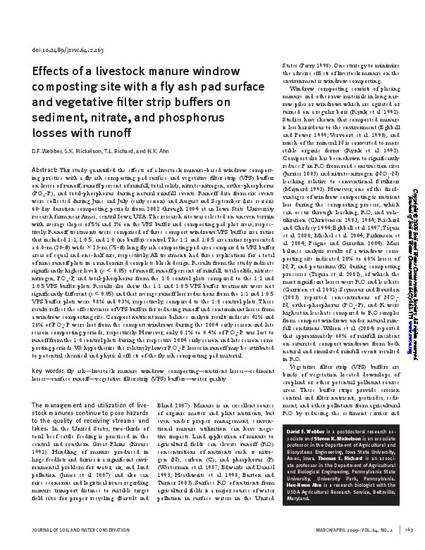
This study quantified the effects of a livestock manure-based windrow composting practice with a fly ash composting pad surface and vegetative filter strip (VFS) buffers on losses of runoff, runoff percent of rainfall, total solids, nitrate-nitrogen, ortho-phosphorus (PO4-P), and total-phosphorus during natural rainfall events. Runoff data from six events were collected during June and July (early season) and August and September (late season) 60-day duration composting periods from 2002 through 2004 at an Iowa State University research farm near Ames, central Iowa, USA. The research site was selected on uneven terrain with average slopes of 5% and 2% on the VFS buffer and composting pad plot areas, respectively. Runoff treatments were comprised of three compost windrows:VFS buffer area ratios that included 1:1, 1:0.5, and 1:0 (no buffer) control. The 1:1 and 1:0.5 area ratios represented a 6.0-m (20-ft) wide × 23-m (75-ft) long fly ash composting pad area compared to VFS buffer areas of equal and one-half size, respectively. All treatments had three replications for a total of nine runoff plots in a randomized complete block design. Results from the study indicate significantly higher levels (p < 0.05) of runoff, runoff percent of rainfall, total solids, nitrate-nitrogen, PO4-P, and total-phosphorus from the 1:0 control plots compared to the 1:1 and 1:0.5 VFS buffer plots. Results also show the 1:1 and 1:0.5 VFS buffer treatments were not significantly different (p < 0.05) and that average runoff loss reductions from the 1:1 and 1:0.5 VFS buffer plots were 98% and 93%, respectively, compared to the 1:0 control plots. These results reflect the effectiveness of VFS buffers for reducing runoff and contaminant losses from a windrow composting site. Compost nutrient mass balance analysis results indicate 41% and 26% of PO4-P were lost from the compost windrows during the 2004 early season and late season composting periods, respectively. However, only 0.1% to 0.4% of PO4-P was lost to runoff from the 1:0 control plots during the respective 2004 early season and late season composting periods. We hypothesize the relatively lower PO4-P losses in runoff may be attributed to potential chemical and physical effects of the fly ash composting pad material.
Available at: http://works.bepress.com/steven_mickelson/15/

This article is from Journal of Soil and Water Conservation 64, no. 2 (March/April 2009): 163–171, doi:10.2489/jswc.64.2.163.